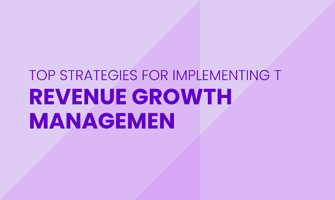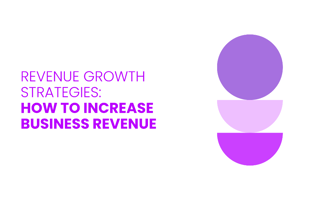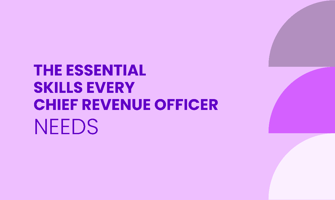Revenue Growth Management (RGM) is essential because it helps businesses identify and seize...
What You Need to Know About Revenue Optimization
Revenue optimization is the process of maximizing a company’s income by aligning pricing, sales, and marketing strategies with customer behavior and market trends.
It involves using data-driven insights to make smarter decisions that boost profitability without increasing operational costs. Whether you’re in retail, SaaS, or hospitality, revenue optimization helps you unlock growth potential by targeting the right customers and refining your offerings. This article will tell you about the key components, tools, and strategies involved in revenue optimization and how businesses can leverage them to achieve sustainable growth.
Discover how "revenue intelligence" impacts decision-making in our article: "What is Revenue Intelligence? How It Works and Why It Matters."
What Is Revenue Optimization?
Revenue optimization is a critical concept for any business aiming to grow and succeed. It focuses on maximizing income by improving how you generate and manage revenue.
This process goes beyond simply earning money it’s about strategically analyzing and improving every revenue stream to boost profitability. At its core, revenue optimization helps you identify opportunities within your existing business model.
These opportunities might involve increasing sales, better targeting your customers, or adjusting your pricing strategies. By focusing on these areas, you can work toward sustainable growth Instead of short-term gains. This approach ensures that your business remains competitive and profitable over time.
To make smart decisions in revenue optimization, data plays a key role. Businesses today rely on data and analytics to find patterns in customer behavior, market trends, and operational performance.
For example, data can help you answer questions like: Which products or services generate the most revenue? Are customers willing to pay more for certain features? How do seasonal trends affect sales?
The insights drawn from such data allow you to take action. For example:
You might shift resources toward high-performing products.
Adjust pricing to match market demand.
Create personalized offers to win over specific customer groups.
Another benefit of using analytics is that it makes your business adaptable. Markets and customer preferences are always changing. With data guiding your decisions, you can respond quickly to these changes and minimize risks to your revenue.
![]()
Key Components of Revenue Optimization
1. Data-Driven Decision Making
To make better decisions about growing your revenue, you need to rely on data. Without it, you're just guessing. By analyzing your sales data, you can find patterns and opportunities that might not be obvious at first.
For example, you can look at which products or services sell the most during certain times of the year or identify which sales channels bring in the most money. These insights help you focus your efforts on areas where you can achieve the biggest results.
Understanding how your customers behave is another way data helps you make smarter choices. When you study things like purchase history, browsing habits, and feedback, you can discover what different groups of customers want.
This allows you to create more personalized strategies to meet their needs. For example, if you notice that a group of customers frequently returns to buy a specific product, you could offer them a loyalty discount or bundle related items together to encourage larger purchases.
Here are some key ways data-driven decision-making can improve revenue strategies:
Spotting trends in sales performance: Which products or services are consistently strong performers? Which ones need improvement?
Pinpointing customer preferences: What do your customers buy most often? What do they stop buying, and why?
Identifying untapped opportunities: Are there specific regions, customer demographics, or product categories you’re missing out on?
Platforms like 180ops make this process even more effective by consolidating data from multiple touchpoints and providing actionable insights. For instance, 180ops can highlight underperforming channels or emerging customer segments, helping you make timely adjustments to your strategy.
By using this information, you can adjust your pricing, promotions, and inventory to boost revenue. For example, if data shows that customers tend to buy more during a particular season, you can plan targeted campaigns to maximize sales during that time.
Or, if you notice that certain products sell better when bundled, you can create packages that encourage higher spending.
The key to success is to use your data consistently. Without regular analysis, you might miss important shifts in customer behavior or market trends. With data as your guide, your decisions become clearer, more focused, and more effective in driving revenue growth.
2. Dynamic Pricing Strategies
Dynamic pricing is a powerful way to help businesses maximize their revenue by adjusting prices in real-time. Instead of sticking to fixed prices, this strategy allows you to respond quickly to changes in market demand, customer behavior, or external factors like competition or supply chain disruptions.
The flexibility of dynamic pricing helps ensure that your prices are always aligned with what customers are willing to pay. There are different methods you can use to make dynamic pricing even more effective:
Segmented pricing: This involves setting different prices for different customer groups. For example, you might offer discounts for students or charge premium prices for business travelers. By tailoring prices to specific groups, you can better capture the value each group is willing to pay.
Personalized pricing: With this approach, prices are customized for individual customers based on their buying history, preferences, or even how they interact with your website. For example, returning customers might see lower prices as a reward for their loyalty, while new customers might be shown introductory offers to encourage their first purchase.
Surge pricing: Often used in industries like ride-hailing or ticketing, surge pricing increases prices during periods of high demand. When more people want a product or service at the same time, raising the price helps manage that demand while boosting revenue. For example, concert tickets might cost more as the event date gets closer and availability decreases.
Dynamic pricing works best when it’s supported by accurate data and technology. Tools like artificial intelligence or machine learning can analyze customer trends, market conditions, and even competitors’ prices to suggest optimal pricing changes.
This ensures that your adjustments are data-driven and not based on guesswork. Ultimately, dynamic pricing helps you balance profitability with customer expectations. By setting the right price at the right time, you can maximize revenue while staying competitive in your market.
3. Customer Segmentation
Grouping your customers into distinct categories, known as customer segmentation, is an essential way to improve revenue opportunities.
By identifying specific groups within your audience, you can focus your efforts more effectively, delivering what each group needs and values the most. This helps you maximize the potential of every interaction with your customers.
When you segment your customers, you can tailor your approach in key areas like marketing, pricing, and product offerings. Each group has its preferences, behaviors, and expectations. By understanding these differences, you can create strategies that resonate with them and drive better results.
For example, customer segmentation allows you to:
Personalize marketing campaigns: Instead of sending the same message to everyone, you can craft targeted campaigns that speak directly to the interests and pain points of each segment. A family shopping for groceries might respond differently to a promotion than a single professional looking for meal kits.
Adjust pricing strategies: Different customer groups might have different price sensitivities. You might offer discounts to value-conscious shoppers while positioning premium options for those willing to pay more for added features or exclusivity.
Develop tailored product offerings: Some customers might prefer one type of product over another. By segmenting, you can highlight the products most relevant to each group, improving the likelihood of a purchase.
The cause-and-effect relationship here is straightforward: when you align your strategies with the unique needs of each segment, customers feel understood and are more likely to engage with your business. This increased engagement leads to higher revenue.
Customer segmentation is also useful for identifying opportunities to cross-sell or upsell. By analyzing each group’s behavior, you can suggest complementary products or premium versions that meet their needs.
For example, a customer who frequently buys outdoor gear might appreciate recommendations for related items like hiking boots or backpacks. Using segmentation doesn’t just boost immediate revenue.
It also builds trust and loyalty. When customers see that your business understands them, they are more likely to return, increasing their lifetime value.
4. Cross-Selling and Upselling
Cross-selling and upselling are effective ways to increase revenue by focusing on your existing customers. Both strategies aim to improve their buying experience while boosting your sales.
Cross-selling encourages customers to purchase complementary products that go well with what they already plan to buy. For example, if a customer buys a smartphone, you might suggest a phone case or screen protector to go with it.
This not only increases the value of their purchase but also helps them get more out of the product they’re buying. By offering items that naturally fit together, you can improve their overall satisfaction while generating more income.
Upselling involves offering customers a higher-value option than what they’re considering. You show them the benefits of choosing a premium or upgraded version of a product or service.
For example, if someone is looking at a basic subscription plan, you could explain how the premium plan includes additional features that meet their needs better. This approach can create an additional revenue stream while giving the customer more value for their money.
Both strategies work best when they are tailored to what the customer truly needs or finds useful.
5. Operational Efficiency
Streamlining your operations is important to optimizing revenue. Efficient processes help businesses work faster, make fewer mistakes, and focus on what truly drives income.
One way to boost operational efficiency is by improving your sales processes. Inefficient sales workflows can create bottlenecks, slowing down how quickly revenue comes in.
By simplifying steps, removing unnecessary tasks, or improving communication between teams, you can close deals faster and serve customers better. A faster, more focused sales cycle leads to quicker revenue generation and fewer opportunities slipping through the cracks.
Another key approach is to use automation for repetitive tasks. Many routine activities, such as data entry or sending follow-up emails, take up valuable time and are prone to errors. Automating these tasks ensures they are done accurately and frees up your team to focus on higher-value work. For example:
Automating payment processing can reduce delays and errors in collecting revenue.
Using software to schedule meetings or send reminders can save hours for your sales team.
Automatically updating customer records in your CRM system reduces manual mistakes and provides accurate data for decision-making.
By saving time and improving accuracy, automation allows your team to concentrate on activities like building relationships, creating strategies, or identifying new revenue opportunities.
![]()
Why Revenue Optimization Matters for Businesses
Revenue optimization is important for ensuring your business thrives in a competitive market. It helps you make the most of your income opportunities while building a foundation for long-term success.
One of the most important benefits of revenue optimization is how it increases profitability. By carefully managing your pricing strategies, customer relationships, and operations, you can capture more value from both existing and potential revenue streams.
For example, optimizing pricing might mean adjusting what you charge based on demand or customer segments, which ensures you’re not leaving money on the table. This approach directly boosts your bottom line, allowing your business to make more money without necessarily needing to increase costs.
Revenue optimization also plays a key role in supporting sustainable growth. As your business grows, it’s critical to maintain financial health.
Revenue optimization ensures your income keeps pace with your expansion by helping you adapt to changing customer behaviors, market trends, and economic conditions. This adaptability makes it easier to scale your business without overextending resources or risking financial instability.
Another significant impact of revenue optimization is how it improves customer lifetime value (CLV). CLV measures the total revenue a customer generates over their entire relationship with your business.
When you focus on revenue optimization, you can create strategies to encourage repeat purchases and longer-term loyalty.
For example, by tailoring offers to specific customer needs or introducing personalized upsell opportunities, you can keep customers engaged and spending more, which leads to recurring revenue and higher profits over time.
In summary, revenue optimization benefits your business in three key ways:
Maximizing profitability by optimizing current and new income opportunities.
Enabling sustainable growth through smarter financial management and adaptability.
Increasing customer lifetime value drives long-term revenue and builds stronger customer relationships.
Each of these outcomes reinforces the health and success of your business, making revenue optimization a strategy you can’t afford to overlook.
Tools and Technologies for Revenue Optimization
Tools and technologies play a critical role in implementing revenue optimization strategies effectively. These solutions help businesses collect and analyze data, forecast trends, and automate decision-making.
Customer Relationship Management (CRM) Systems: CRM tools track customer interactions and provide insights into buying behaviors, allowing businesses to tailor their marketing and sales strategies.
Analytics Platforms: Tools like business intelligence (BI) software helps businesses visualize and interpret data from various sources, such as sales reports, website traffic, and customer demographics.
Dynamic Pricing Tools: These platforms adjust prices in real-time based on demand, competition, and market conditions. They are especially useful in industries like e-commerce and hospitality.
AI and Machine Learning Technologies: Advanced algorithms can process vast amounts of data to predict customer behavior, identify trends, and recommend optimal pricing or marketing strategies.
Revenue Intelligence Platforms: Tools like 180ops specialize in providing actionable insights by combining data from multiple touchpoints.
180ops helps businesses align their pricing, marketing, and sales strategies, ensuring that decisions are backed by accurate and relevant information. By leveraging such platforms, companies can improve revenue forecasting and make data-driven decisions that enhance profitability.
These tools enable businesses to identify opportunities for growth, allocate resources effectively, and stay competitive in dynamic markets.
Conclusion
Revenue optimization is a vital strategy for businesses aiming to maximize profits while maintaining efficiency. By understanding customer behavior, leveraging dynamic pricing, and using advanced analytics tools, companies can make informed decisions that drive revenue growth.
It’s not just about increasing sales; it’s about improving margins, retaining high-value customers, and staying competitive in an evolving market. Platforms like 180ops offer actionable insights to streamline this process, ensuring that businesses can identify opportunities for optimization and capitalize on them effectively.
Adopting revenue optimization strategies not only enhances short-term performance but also lays the groundwork for long-term success in any industry.
FAQ
1. What is revenue optimization?
Revenue optimization is the process of maximizing a company’s revenue by analyzing data, adjusting pricing strategies, and improving operational efficiency. It focuses on aligning business efforts to meet customer demands and market conditions.
2. Why is revenue optimization important?
Revenue optimization is important because it helps businesses:
Maximize profit margins without significant cost increases.
Retain high-value customers by offering tailored solutions.
Stay competitive by adapting to market trends and customer needs.
3. What are the key strategies for revenue optimization?
Key strategies include:
Dynamic pricing adjustments based on demand and competition.
Customer segmentation to target high-value groups.
Cross-selling and upselling to boost average transaction value.
4. Which industries benefit the most from revenue optimization?
Industries like retail, hospitality, SaaS, and e-commerce benefit greatly from revenue optimization. These sectors rely on customer behavior insights and dynamic pricing to maximize profitability.
5. How do tools like 180ops help with revenue optimization?
Platforms like 180ops provide actionable insights by analyzing data from multiple sources. They help businesses track customer behavior, forecast revenue trends, and make informed decisions to optimize pricing, marketing, and sales strategies.




